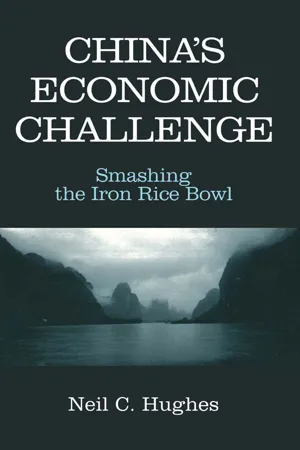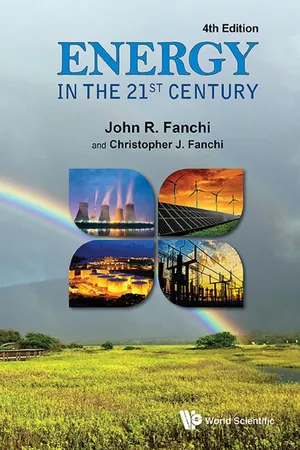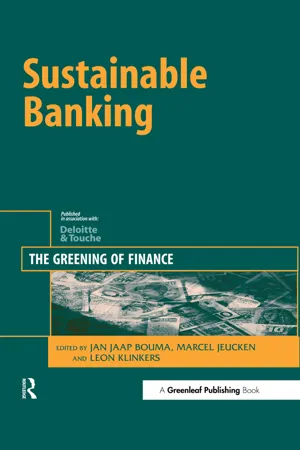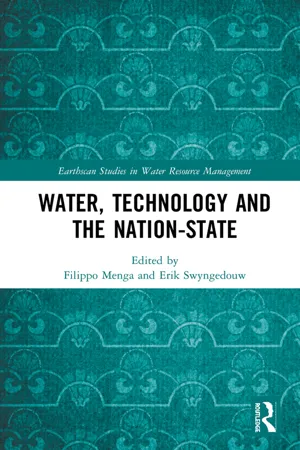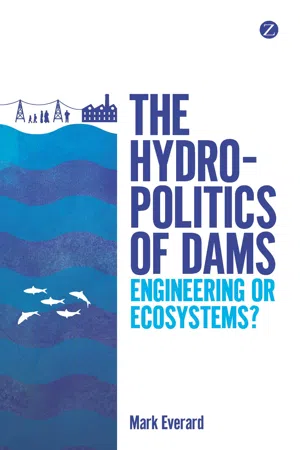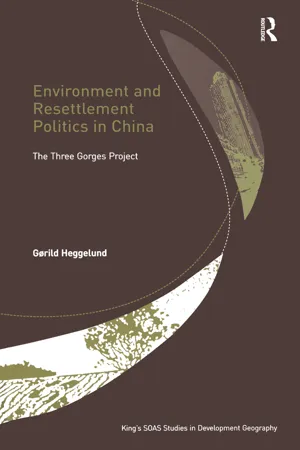Technology & Engineering
Three Gorges Dam
The Three Gorges Dam is a massive hydroelectric dam on the Yangtze River in China. It is the world's largest power station in terms of installed capacity and plays a crucial role in flood control, electricity generation, and improving navigation. The dam has been a subject of controversy due to its environmental and social impacts, but it remains a significant feat of engineering.
Written by Perlego with AI-assistance
Related key terms
Related key terms
1 of 4
Related key terms
1 of 3
10 Key excerpts on "Three Gorges Dam"
- eBook - ePub
China's Economic Challenge: Smashing the Iron Rice Bowl
Smashing the Iron Rice Bowl
- Neil C. Hughes(Author)
- 2016(Publication Date)
- Routledge(Publisher)
Chapter Five The Three Gorges Dam RevisitedApproaching the Three Gorges.Passage contains an image
W hen China celebrated fifty years of Communism on October 1, 1999, Premier Zhu Rongji proudly hailed the enormous achievements of the Chinese people, particularly the economic transformation undertaken during the previous twenty years. But the project that is meant to symbolize these achievements remains mired in controversy. Since it was first proposed by Sun Yatsen in 1919, the idea of damming the Three Gorges of the Yangtze River and constructing the world’s largest hydroelectric generation and water-control project has fascinated China’s leaders. Although the project had the personal endorsement of Mao Zedong and Deng Xiaoping, internal opposition was surprisingly strong and was silenced only during the crackdown on dissent after the 1989 Tiananmen protest. Meanwhile, international criticism—especially of the project’s far-reaching environmental impacts—rose to a fever pitch. The United States and Canadian governments and the World Bank and Asian Development Bank, which had showed initial interest in the project, quickly backed away. China went ahead anyway, determined to make the Three Gorges Dam the crowning success of its drive to modernize its economy. The first earth was moved in 1993, and by the end of 1997, two giant cofferdams enclosed the Yangtze River and construction of the dam itself had begun. Even die-hard opponents realized that nothing would stop the project, and the furor died down.Although other dams are bigger, Three Gorges will consume 27 million cubic meters of concrete, almost enough to pave over Washington, D.C. It will be capable of generating two-thirds more energy—84 billion kilowatt hours per year—than any other dam in the world. The dam will be 1.2 miles wide and 185 meters high. Behind it the water level will rise as high as 175 meters, submerging 10 percent of the Three Gorges, 13 cities, 140 towns, 360 villages, 1,300 known archaeological sites, and 62,000 acres of farms and orchards, and will create a reservoir 632 kilometers long. By its own admission, the government will have to resettle at least 1,133,800 people who presently live in the reservoir area below the 175-meter level. According to official 1997 estimates, it will cost US$24.4 billion. The dam is scheduled to enter into full operation in 2009, seventeen years after construction officially began. - eBook - ePub
Transforming Electricity
The Coming Generation of Change
- Walt Patterson(Author)
- 2013(Publication Date)
- Routledge(Publisher)
2TURMOIL IN THE FOREGROUNDThree GorgesThe most controversial engineering project in the world is a power station – among other things. If all goes to plan, it will be by far the largest power station in the world. The Three Gorges Project, now under way on the Yangtze River in central China, is scheduled to produce 18 giga watts of electricity, enough to power at least 18 medium-sized cities all by itself. The centrepiece of the Project is a dam that will be 2 kilometres wide and 185 metres high. Like the Great Wall to the north, the Three Gorges Dam, and the vast reservoir it will create for some 600 kilometres upstream, will probably be visible from the moon. All the numbers associated with the Project are record-breaking. By the time the power station is reaching full output, expected in 2009, the Project will have cost an estimated US$30 billion. It will flood 2800 square kilometres of land, including the Qutang, Wu and Xiling Gorges, regarded as among the most spectacular scenery in the world. It will also displace more than 1.3 million people, as their villages disappear under the rising waters.The Chinese government hails the Project not only for its anticipated contribution to satisfying China’s soaring demand for electricity, but also as a way to tame the turbulent Yangtze. The surging river stretches 6300 kilometres, from the highlands of Sichuan in western China, until it reaches the China Sea through a vast estuary north of Shanghai. The Yangtze’s periodic floods cause devastation and kill tens of thousands along its banks. Those of 1998 were the worst for 40 years. As long ago as 1920 China’s revolutionary leader Sun Yat-sen proposed to dam the Three Gorges for flood control and hydroelectricity. The idea has attracted vigorous support and equally vigorous denunciation ever since.In 1992, overriding years of outspoken internal opposition, the Chinese government at last announced the go-ahead for Three Gorges. The controversy immediately spilled over into the international arena. Critics charged that the environmental impact of the Project on the hydrology, fish stocks and agricultural land along the river would be not beneficial but deleterious. They decried the forced eviction of more than a million people and doubted that resettlement could compensate for their losses. Some specialists argued that other ways of providing electricity would be cheaper, more economic and more effective than a single enormous power station taking more than a decade to build. The World Bank, hitherto a frequent funder of major hydroelectric projects, decided that it would not participate in Three Gorges, on the basis that it was not economic, and raised concerns about its impact on the environment and human rights. - eBook - ePub
- John R Fanchi, Christopher J Fanchi;;;(Authors)
- 2016(Publication Date)
- WSPC(Publisher)
Figure 8-4. Hydroelectric Energy Consumption in the United StatesAdverse environmental effects include flooding upstream of the dam, and changing river flow downstream of the dam. These effects occur wherever a dam is built. The Case Study below illustrates some adverse environmental effects of hydroelectric power for a recent hydroelectric power project in China.8.2CASE STUDY : THREE GORGES DAM
The Three Gorges Dam was the world’s largest hydroelectric dam when it was completed [International Rivers, 2009; Three Gorges Geography, 2014, Three Gorges Power, 2016]. Built on the Yangtze River in China, dam construction began in 1994 and was completed in 2008. At completion, the Three Gorges Dam is 185 meters (607 feet) high and 2,309 meters (7,575 feet) wide. Its reservoir extends 660 kilometers (410 miles) behind the dam. The power plant portion of the dam went online in October 2008 with 26 generators. The plant provided a total capacity of 18,300 MW. Additional generators are being added. The dam with 32 main generators cost US$59 billion.Supporters of the Three Gorges Dam project consider it to be a symbol of China’s technological and economic progress. The dam helps decrease China’s carbon output and creates a renewable source of energy for China’s expanding economy. The dam reduces the potential for downstream floods on the Yangtze, a problem that has historically plagued inhabitants along the river’s shore. Control over the river’s flow makes river navigation easier.Since its inception, the Three Gorges Dam has been highly controversial. The Yangtze River is among the world’s longest rivers, and the Yangtze River valley has been heavily populated for thousands of years. When a river of this magnitude is dammed, the water must be stored somewhere. The reservoir formed behind the Three Gorges Dam forced relocation of approximately 1.3 million people. Artifacts and ruins from thousands of years of Chinese history were submerged by the reservoir. - eBook - ePub
Sustainable Banking
The Greening of Finance
- Jan Jaap Bouma, Marcel Jeucken, Leon Klinkers, Jan Jaap Bouma, Marcel Jeucken, Leon Klinkers(Authors)
- 2017(Publication Date)
- Routledge(Publisher)
One massive electricity project requiring innovative funding options drawing on the resources of emerging financial markets is the Three Gorges Hydroelectric Power Scheme. An icon of China’s modernising ambition (Hajari 1999), the Three Gorges Dam Project has proven to be something of a test case for operationalising the SD concept within the international financial services sector, arousing the interest of environmental and human rights groups across the globe. The prospect of similar mega-dams being proposed in China and in other emerging economies means that international financiers’ policies on the Three Gorges Project can be seen as setting precedents. Such precedents can either aid or hamper efforts to promote sounder environmental policies within the international financial services sector, and, by implication, in the worldwide energy and power sectors.25.1.1 The Three Gorges Hydroelectric Power SchemeThe Three Gorges Hydroelectric Power Scheme currently under construction on China’s Yangtze River is expected to cost more than virtually any other single construction project in history. Financial costs pale, however, in comparison to the ecological costs of submerging around 23,800 hectares of land and the social and human costs of resettling well over a million people. More than 1,700 towns and villages will be flooded, and 300,000 farmers are having to relocate onto mostly poorer soils. The project is said to pose significant ecological dangers, technical challenges and human rights issues, and to lead to the loss of important archaeological sites and cultural artefacts (Probe International 1998).The large size of the project and its financial and technical dimensions alone constitute a need for international involvement. Involving the diversion of China’s longest river and the construction of a 600 km-long lake, the Three Gorges Dam Project is predicted to be capable of pumping out 18,200 megawatts of electricity, significantly more than any other hydro power station in the world (Inside China Today 1999).2 As well as powering China’s industrialisation, the project is designed to open the river above the gorges for shipping. Whether it is the best means of allowing China to hold back from burning its vast coal reserves, and whether it will provide for the much-vaunted and much-needed flood protection downstream, are more matters of conjecture (Pearce 1997). Project civil works officially began in December 1994 with an estimated completion date between 2009 and 2013 (China Embassy 1997). Estimated costs from China, as late as 1996, ran to US$28 billion (Razavi 1996), while international estimates predict costs up to US$75 billion (Kojima et al. - eBook - ePub
- Filippo Menga, Erik Swyngedouw, Filippo Menga, Erik Swyngedouw(Authors)
- 2018(Publication Date)
- Routledge(Publisher)
13Building a dam for China in the Three Gorges region, 1919–1971 Covell F. MeyskensIn the early twentieth century, Chinese leaders began to contemplate building a large dam on the Yangzi River that would generate electricity, boost river transport, and end its history of floods. They paid particular attention to the Three Gorges region, where the river ended its descent from the Sichuan Basin into Hubei province’s Jianghan Plain. This chapter examines Chinese efforts to construct a dam near the Three Gorges between 1919 and 1971. It concentrates on this block of time, because the first dam proposal appeared in 1919, and the Gezhouba Dam became that place in 1971. Past scholarship has overlooked this period and focused on the building of the Three Gorges Dam (TGD) in the 1990s (Dai, 1998).I take a different tack and trace the Chinese government’s aspiration to make a TGD to a new understanding of technology’s power precipitated by Western imperialist pressures in the mid-nineteenth century. Prior to Western imperialism’s arrival, elites in China did not take the rapid expansion of technological power as a primary economic goal (Wong, 1997; Elvin, 1973). This changed when Western imperialists and their scion – Meiji Japan – used technological strength to assert influence over East Asia. In response, elites in China embraced the Western notion that technological self-strengthening was central to a country’s economy and that its territory was a repository of resources useful for industrialization (Halsey, 2015; Wu, 2015; Pietz, 2014).After laying this historical groundwork, the chapter highlights three defining features of Chinese efforts to erect the TGD. First, Chinese elites manifested a belief in the national benefits of technologically redesigning the environment of the entire Yangzi region. Second, Chinese leaders acted like nationalist elites in other late-developing countries and advocated using state power to advance industry (Gerschenkron, 1962: 5–30). Third, Chinese elites repeatedly sought out foreign assistance to offset domestic shortages of industrial capital. These three trends engendered two approaches to technology, or what Thomas Hughes (1983) calls technological styles, which reflected different understandings of how to use experts, labor, and capital. - eBook - ePub
Renewable Energy in East Asia
Towards a New Developmentalism
- Christopher M. Dent(Author)
- 2014(Publication Date)
- Routledge(Publisher)
Box 6.2 will, though, serve as a good representative illustration in this regard for at least large-hydro development. The TGD’s story also connects closely with many historic challenges of China’s hydropower development. Like other large-hydro dam projects, it has too shown the importance of fostering more effective stakeholder relations among national government, local government, developer companies, and local communities, as well as adopting a more holistic and effective approach to environmental impact assessments.China also faces challenges related to the now-limited site options for new large-hydro projects. Box 6.1 examined the prospects for future small-hydro development and noted some problems on this front too; it was concluded that supporting a more widespread deployment of pico-hydro and micro-hydro installations had a number of advantages. Finally, there is the challenge of ensuring that the internationalisation of China’s hydropower industry acts as a benign force for sustainable development in other countries. This relates to similar debates concerning its wind and solar energy counterparts, and how China is playing an increasingly effective role in advancing renewable energy development globally.Box 6.2 The Three Gorges Dam: clean energy hero or villain?China’s Three Gorges Dam (TGD) on the Yangtze River is both hero and villain of the country’s renewable energy development. Becoming fully operational in May 2012 with an installed capacity of 22.5 GW, the TGD has been a flagship project of Chinese economic development generally. Its annual ‘clean energy’ savings of 31 million tonnes of coal and 100 million tonnes of greenhouse gas emissions make a significant contribution to decarbonising China’s energy sector. Yet, the huge socio-economic and environmental costs arising from both the TGD’s construction and operation have made it highly controversial and a target of much criticism, inside and outside the country. - eBook - ePub
The Global Environment
Institutions, Law and Policy
- Norman J. Vig, Regina S. Axelrod(Authors)
- 2023(Publication Date)
- Routledge(Publisher)
24. A major critic of hydropower throughout the world has made this argument for all big dams, which he believes violate the fundamental principles of sustainable development. Patrick McCully, Silenced Rivers: The Ecology and Politics of Large Dams (London: Zed Books, 1997), 140. Species endangered by the Three Gorges Dam include the Chinese river dolphin, the Yangtze River sturgeon, and the Siberian crane.- 25. See “Project Title: China: Efficient Industrial Boilers,” Proposal to the World Bank Global Environmental Trust Fund (http://www.worldbank.org/htm/def ).
- 26. Fei Xiaotong, Peasant Life in China: A Field Study of Country Life in the Yangtze Valley (New York: Dutton, 1939), 181.
- 27. Estimates of the annual flow of rock and earth into the Yangtze range from 40 million to 640 million tons. Vaclav Smil, The Bad Earth: Environmental Degradation in China (Armonk, N.Y.: Sharpe, 1984), 87.
- 28. Jun Jing, “Rural Resettlement: Past Lessons for the Three Gorges Project,” China Journal
- eBook - ePub
The Hydropolitics of Dams
Engineering or Ecosystems?
- Mark Everard(Author)
- 2013(Publication Date)
- Zed Books(Publisher)
Many environmental benefits are claimed for the dam. Notably, these include reduction of emissions of air pollutant and greenhouse gases relative to traditional (often coal-fired in China) forms of energy generation. There is also a claimed reduction in greenhouse gas emissions due to navigation by ships through the locks of the Three Gorges Dam, which is planned to increase the freight capacity of the river sixfold. However, some critics claim that heavy siltation will clog ports such as Chongqing within a few years, based on evidence from other dam projects.Although the dam’s official website claims that the first target of the Three Gorges Project is flood control, the hydrological benefits of the dam are less clear. The project is intended to moderate flows of the Yangtze river by intercepting seasonal rains with its 20-million-cubic-metre capacity for floodwater detention, elevating flood protection in the downstream Jingjiang section of the river from ten-year to 100-year events. It is claimed that the dam will also help control the consequences of rare (but increasing under climate-change scenarios) 1,000-year flood events. However, once filled, reservoir surfaces lack buffering capacity, potentially exacerbating the effects of extreme flooding previously buffered by interaction with wetland habitats and floodplains across the catchment. The July 2010 floods that saw the Three Gorges Dam overtop, contributing to loss of life, are a horrific reminder of impacts that may intensify in an increasingly less stable climate. Recognizing the value of ecosystems to catchment hydrology, China is now investing substantially in reforestation to reverse a history of tree loss heavily implicated in damage caused by flooding in 1998,8 including the loss of 4,150 human lives, forced relocation of 18.4 million people and a cost of 255 billion yuan (equivalent to $US37 billion).Wetlands lost by dam filling may be crucial for some scarce species, such as the critically endangered Siberian crane. The dam is also implicated in the functional extinction of the Baiji (the Yangtze river dolphin). Populations of the Yangtze sturgeon, classified by the IUCN as Critically Endangered,9 - eBook - ePub
Environment and Resettlement Politics in China
The Three Gorges Project
- Gørild Heggelund(Author)
- 2017(Publication Date)
- Routledge(Publisher)
In 1994, a ceremony was held to mark the official beginning of the actual construction of the dam with the participation of Li Peng. 77 The construction of the dam is divided into three major phases, the first one covering the period from 1994-1997. The closure of the river that took place 8 November 1997 signifies the end of the first phase. During this phase a diversion canal for navigation was constructed. This canal opened for navigational services on 6 October 1997, meaning that all ships have stopped using the main river for navigation. The work in the first phase has mainly involved preparations for the construction of the main dam. The second phase, 1998-2003, is the crucial period for the project, when two coffer dams (each 76 metres high) must be constructed in order to facilitate the work on the high dam. During this stage the first turbines (14) on the north bank of the river will be installed. In December 2002 a second river closure took place in the diversion channel. During spring 2003 the river will be closed for navigation for about two months. Power generation is scheduled to begin in 2003 when the water levels will reach 135 metres. In the third phase, 2004-2009, the final 12 generators will be put in place in order to achieve the goal of 18,200 MW installed capacity. The permanent ship lifts and sluices will also be completed in this phase. Since the construction of the project began in 1993, until the end of 2002, 645,200 people had been resettled. 78 As the Three Gorges resettlement is discussed in Chapters 4 and 5, further mention will not be necessary here. The Three Gorges Project Leadership and Actors In order to understand the decision-making structure for the project, let us take a brief look at the institutional picture for the dam project. Central Commissions (weiyuanhui) and leading groups (lingdao xiaozu) that are directly under the Party apparatus or the State Council are important in the shaping of policy in China - eBook - ePub
Green Development
Environment and Sustainability in a Developing World
- Bill Adams(Author)
- 2019(Publication Date)
- Routledge(Publisher)
Chapter Twelve Engineering developmentDOI: 10.4324/9780203386033-1212.1 The Power of Infrastructure
A huge concrete dam has risen across the bed of the vast Blue Nile River in Ethiopia, not far above the Sudanese border. The area is remote, about 500km north from Addis Ababa. When completed, the concrete wall of the Grand Ethiopian Renaissance Dam (GERD) will be 1,800m long and 155m high, with a rock-filled dam stretching a further 5km. The dam will impound 74 billion m³ of water, and its spillway will be able to pass floods of 15,000 cubic metres per second. Its sixteen hydroelectric turbines will generate over 6,000MW of electricity, probably yielding 15,000GWh per year. It will be the largest generator of electricity in Africa and one of the largest in the world.The GERD project is not without controversy. It has been dogged by delay and associated cost over-runs (work began in 2011, and it was originally due to be finished by 2018). In August 2018, the government cancelled the contract with the state-owned company installing the turbines and compensated the dam contractor for the delay (Pilling 2018 ). The Ethiopian Prime Minister is reported to have said ‘We have handed over a complicated water dam project to people who have not seen a dam in their life and if we continue in that direction, the project may never see the light of day’ (Tawfeek 2018 ). But completion would by no means end the controversy. The dam has caused political conflict with Egypt, where some argue that the dam contravenes the 1902 Anglo-Ethiopian Nile Treaty and the 1993 Framework Cooperation instrument signed between Egypt and Ethiopia. Extensive negotiations between Ethiopia, Egypt and Sudan led to a measure of agreement (Yihdego et al.2016), but commentators still speak of the prospect of a ‘water war’ over the hydrological impact of the new dam (Leithead 2018 ), particularly during the filling of its reservoir (at 74 billion cubic metres, the dam will hold back 1.5 times the annual flow of the river,Wheeler et al.
Index pages curate the most relevant extracts from our library of academic textbooks. They’ve been created using an in-house natural language model (NLM), each adding context and meaning to key research topics.
Explore more topic indexes
Explore more topic indexes
1 of 6
Explore more topic indexes
1 of 4
